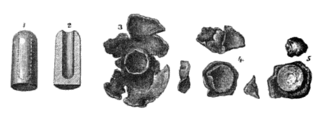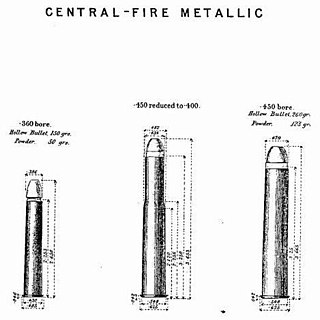
The term express was first applied to hunting rifles and ammunition beginning in the mid-19th century, to indicate a rifle or ammunition capable of higher than typical velocities. The early express cartridges used a heavy charge of black powder to propel a lightweight, often hollow point bullet, at high velocities to maximize point blank range. Later the express cartridges were loaded with nitrocellulose-based gunpowder, leading to the Nitro Express cartridges, the first of which was the .450 Nitro Express.

The Nitro Express (NE) series of cartridges are used in large-bore hunting rifles, also known as elephant guns or express rifles, but later came to include smaller bore high velocity British cartridges.
The .600 Nitro Express is a large bore Nitro Express rifle cartridge developed by W.J. Jeffery & Co for the purpose of hunting large game such as elephant.
The .577 Nitro Express is a large-bore centerfire rifle cartridge designed for the purpose of hunting large game such as elephant. This cartridge is used almost exclusively in single-shot and double express rifles for hunting in the Tropics or hot climates in general and is a cartridge associated with the golden age of African safaris and Indian shikars.
The .500/450 Magnum Nitro Express is a large bore centerfire rifle cartridge developed by Holland & Holland.
.450 Nitro Express also known as the .450 Nitro Express 31⁄4-inch is a rifle cartridge designed for hunting dangerous game such as elephant, rhino, cape buffalo, lion, and leopard. This cartridge is used almost exclusively in double rifles for hunting in the Tropics or hot climates in general and is associated with the Golden Age of African safaris and Indian shikars.
The .475 Nitro Express is a British rifle cartridge developed in the early 20th century.
The .475 No 2 Nitro Express is a British rifle cartridge developed by Eley Brothers in the early 20th century.

The .450/400 Nitro Express is a Nitro Express rifle cartridge that is produced in three case lengths: 23⁄8-inches, 3 inches and 31⁄4-inches, and is intended for use in single shot and double rifles. The 3-inch and 31⁄4-inch versions are considered classic Nitro Express cartridges.
The .400 Jeffery Nitro Express or .450/400 Nitro Express 3-inch is a medium bore, bottlenecked, Nitro Express cartridge designed by W.J. Jeffery & Co in 1902, intended for use in single shot and double rifles.
The .333 Jeffery and .333 Jeffery Flanged are medium-bore rifle cartridges developed by W.J. Jeffery & Co and introduced in 1908.

The .318 Westley Richards, also known as the .318 Rimless Nitro Express and the .318 Accelerated Express, is a proprietary medium bore centerfire rifle cartridge developed by Westley Richards.
The .350 Rigby and .350 Rigby No 2 are proprietary medium bore rifle cartridges developed by John Rigby & Company.
The .400/350 Nitro Express, also known at the .400/350 Nitro Rigby, is a medium bore rifle cartridge developed by John Rigby & Company.
The .369 Nitro Express, also known as the .369 Purdey Nitro Express, is a centerfire, rifle cartridge developed by James Purdey & Sons and introduced in 1922.
The .450 Black Powder Express, also known as the .450 31⁄4-inch BPE, was a popular black powder cartridge in the late 19th and early 20th century.
The .577 Black Powder Express is a series of black powder cartridges of varying lengths including 21⁄2-inch, 23⁄4-inch, 3-inch and 31⁄4-inch.

The .450/400 Black Powder Express cartridges were black powder rifle cartridges introduced in the United Kingdom in the 1880s.
The .400/360 Nitro Express cartridges are a number of very similar, but not interchangeable, centerfire rifle cartridges developed by James Purdey & Sons, William Evans, Westley Richards and Fraser of Edinburgh, all at the beginning of the 20th century.
The .360 No. 2 Nitro Express is a centerfire rifle cartridge developed by Eley Brothers and introduced in 1905.






